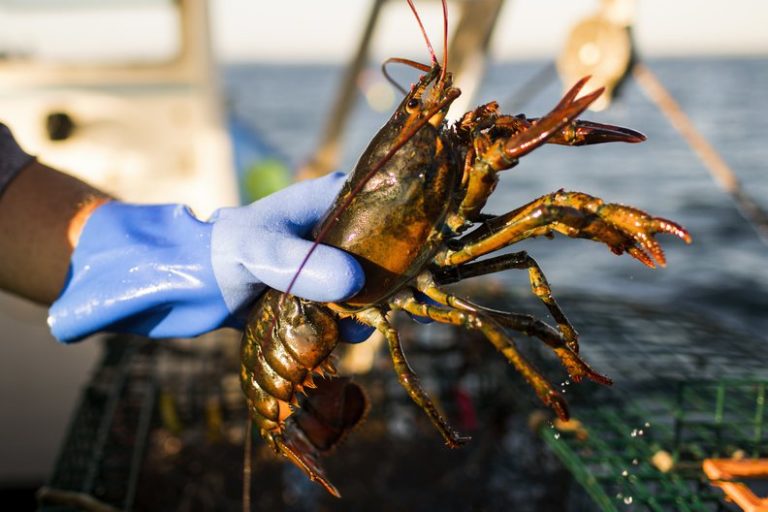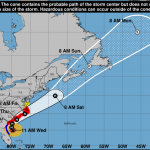With a bit of prodding by some valued colleagues,,,
 With a bit of prodding by some valued colleagues, I’ve decided to resurrect some of my past communications, primarily from my in-house efforts in FishNet-USA but also via other commercial fishing industry publications. Why? You might ask. The main reason is that in spite of my grinding out a surprising number of pages dealing mostly with challenges facing our industry, very little has changed, and some of those changes are for the worse.
With a bit of prodding by some valued colleagues, I’ve decided to resurrect some of my past communications, primarily from my in-house efforts in FishNet-USA but also via other commercial fishing industry publications. Why? You might ask. The main reason is that in spite of my grinding out a surprising number of pages dealing mostly with challenges facing our industry, very little has changed, and some of those changes are for the worse.
But we’re not doing this for any “I told you so” reasons. Rather, we’re doing it so more people in the industry, as well as those folks who value the many significant contributions fishing has made to the character of our coastal communities, can better understand the forces that are – purposely or not – still at work undermining one of our oldest and most culturally significant industries.
As far as the format we will be loosely following, every two weeks either I and or one of my colleagues will choose something I’ve written, pen a brief introduction to it, and then we will either distribute it via email (as we’re doing with the following piece, which is kind of short and with no illustrations) or in cases where the file size could be prohibitively large for email distribution, with a link to the article instead.
While on the subject of links, many of the included links will no longer be operative – remember that changes to websites over the last twenty plus years might well be described as revolutionary. Rest assured that at one point they all worked. If you are really interested in tracking particular linked information down, Google (or any other effective search engine) could be invaluable. If not, send me an email and (with no guarantees) I’ll try to lend a hand.
As always, I’ll be eager to read any comments, either on what I’ve written or on what we are trying to do hear. And while the kudos are always nice to read, I’ve found that I can always do more with substantive criticism.
Thanks,
Nils Stolpe
March 2, 2020
_________________________
Yes Virginia, there is a fake news problem. And it’s a problem that’s been plaguing the commercial fishing industry since environmental activists decided that their financial future lay in the worlds’ oceans.
Writing of which, this is my response to an opinion piece that tries to build a mountain out of what is significantly less than a mole hill. It is built on wrong assumptions (sea scallops are the same as bay scallops), faulty data (sea scallops are overfished), a poor – perhaps non-existent? – understanding of marine biology/ocean systems, an identifiable level of personal pique (Ms. X couldn’t have scallops for dinner), and unjustified and totally erroneous conclusions (Ms. X couldn’t enjoy a scallop dinner because there weren’t enough sharks in the ocean), but in spite of all that the writer, indicts an entire fishery.
As you will see as we continue to discuss past (and current) articles, columns, videos, etc., this is far from an uncommon set of circumstances. Supposedly legitimate journalists, authors, academics, bureaucrats and lay people writing for supposedly legitimate outlets are capable of getting what should be elementary facts wrong when “covering” fisheries issues. I’ve spent a lot of time and effort to bring this to light.
But the struggle still continues, and in spite of the best efforts of too few of us, gross distortions of reality continue to plague the commercial fishing industry, and fish and seafood industry continues to pay the price for those distortions.
(Please note that here I substituted the name of the column’s author to Mr. X)
NS
_________________________
THERE’S WRONG, THERE’S REALLY WRONG AND THEN THERE’S BEING A VOLUNTEER INTERNET “JOURNALIST”
New Jersey Newsroom website gets it all wrong on East Coast scallop fishery.
October 9, 2012
The New Jersey Newsroom website was formed by journalists and ex-journalists, primarily from the Newark (New Jersey) Star Ledger, with collective experience adding up to “over 1,000 years.” On their site those journalists wrote “our contributing writers, driven by passion and purpose, contribute as volunteers who believe in the cause…. NewJerseyNewsroom.com’s goal is to provide high-quality news for New Jerseyans and not just about New Jerseyans. We will do our best to gather all the stories you want, regardless of the original sources.”
Impressive sounding, isn’t it?
Unfortunately, at least judging by a recent article on the scallop fishery off the East coast, the content on the site doesn’t come close to living up to its billing. With particular reference to the “contribute as volunteers” quote, an article posted on their website on September 27 is about as good a demonstration I’ve seen of the old adage “you get what you pay for.”
In Jaws for hire: Fewer sharks mean fewer scallops at the Jersey Shore, Mr. X (name purposely withheld) came to some startling conclusions and yet another undeserved and inaccurate indictment of commercial fishing based on 1) a graphical depiction of a marine foodweb from an article referenced in the current edition of Scientific American, Ecosystems on the brink, and 2) his wife not being able to order scallops at Poor Henry’s restaurant (in Montvale, NJ) because, as related by the server, they didn’t have any that day.
From this beginning he crafted an article in just under 800 words that laid out a plausible sounding argument for the fact that an increase in the price and a decrease in the supply of scallops, as so convincingly demonstrated by his wife’s failure to have her first choice entrée at Poor Henry’s, was due to the unregulated slaughter of oceanic sharks.
Citing the Star Ledger he writes “it’s a near-innocuous business story. Good news about fishing off Cape May, wherein that port has been named the second most prosperous on the East Coast because rising scallop prices have offset diminishing catches of shellfish.”
But, he continues “increased revenues are due to the growing scarcity of scallops, in turn attributable to a complex change in the predatory food chain off the coast of New Jersey.” The argument is so plausible, in fact, that as of this writing it has accumulated 153 Facebook “likes.”
Starting out with Scientific American, the foodweb that impressed Mr. X was derived from research reported in 2007 and 2009 that purportedly showed that a decline in scallop stocks was attributable to a decline in large sharks due to overfishing. (What else would we expect from Scientific American?)
When this research was first published in 2007, there were a few problems with it (see my 2007 National Fisherman column Of sharks and scallops and questionable science at http://www.fishnet-usa.com/natfish_sharks_rays.htm). Regardless of the validity of the conclusions reached by the team of researchers, however, the research very clearly dealt with East coast bay scallops, Argopecten irradians. These are small scallops that, as their common name clearly indicates, live in estuaries.
Getting back to Poor Henry’s and poor Mrs. X, who had to settle for her second choice for dinner, a visit to the restaurant’s website shows that the scallops served there are “Bedford scallops.”
As Mr. X accurately relates in his article, the value of landings by commercial fishermen in New Bedford, Massachusetts has led all other commercial fishing ports in the U.S. for quite a few years, and the reason for this is because of the concentration of scallop vessels there. Hence, I assume, Poor Henry’s geographically focused menu item.
Mr. X informs us that “according to Wikipedia, by far the largest wild scallop fishery in the world is the Atlantic sea scallop (Placopecten magellanicus) found off the northeastern United States and eastern Canada.”
The scallops landed in New Bedford, Cape May, Barnegat Light and other fishing ports on the East coast, the scallops that make up the most valuable fishery in the U.S., are those very same sea scallops.
Not surprisingly, sea scallops spend all of their time – from egg to adult – in the ocean.
Then he writes “according to the (National) Marine Fisheries Service, this wonderful resource is in sad decline.”
Just how much of a decline is the sea scallop fishery experiencing? The below chart, taken from the National Marine Fisheries Service commercial landings online database, shows that landings have been remarkably stable for the last decade. Reductions in allowable landings are currently being considered for fishing years 2013 and 2014, but the fishery is not overfished and overfishing is not occurring.
East Coast Sea Scallop Landings
Year Metric tons Value
2001 21,053.10 $172,582,812
2002 23,891.70 $202,092,361
2003 25,386.80 $229,096,518
2004 29,079.30 $320,038,726
2005 25,685.20 $432,514,317
2006 26,768.20 $384,758,496
2007 26,512.80 $386,044,356
2008 24,215.30 $370,057,384
2009 26,178.90 $374,022,276
2010 25,876.90 $450,965,800
2011 26,618.00 $580,907,132
In fact, the most recent surveys (see New Survey of Ocean Floor Finds Juvenile Scallops are Abundant in Mid-Atlantic at http://www.nefsc.noaa.gov/press_release/2012/SciSpot/SS1208/) have shown that sea scallop recruitment this year was at or near the maximum recorded off the Mid-Atlantic States.
The northeast sea scallop population, at least in terms of large, marketable scallops, appears to be lower that it has been, but measures will be put in place to protect the recruits in the mid-Atlantic, the opening of scallop-rich areas off New England that have been closed to scalloping is being considered, and any reduction in scallop landings will be of a temporary nature.
While Mr. X did manage to get the part about rising scallop prices right, they are higher than they have been because, most knowledgeable people agree, of the rapidly developing middle class in China and the corresponding worldwide increase in the demand for high quality seafood. They prices have been elevated for the last several years, and as the above chart shows, there has been no decline in the harvest up until 2011. This is a definite contradiction of his “increased (scallop) revenues are due to the growing scarcity of scallops.”
The Scientific American food web that Mr. X based his argument about Atlantic sea scallops on dealt with bay scallops and the supposed impact that shark overfishing had on their abundance. Confusedly, Mr. X supports his thesis that shark overfishing has brought about his “sad decline” of sea scallops, not bay scallops. There is no relationship between the abundance of bay scallops and the abundance of sea scallops. There is no relationship between the price of bay scallops and the price of sea scallops. There is no relationship between the abundance – or lack thereof – of large sharks and the abundance of sea scallops, and there is no relationship between the abundance of cownose rays – the assumed predators on bay scallops and the assumed prey of the supposedly missing large sharks – and the abundance of sea scallops.
As a relevant aside, the fisheries for large sharks in U.S. waters has been so stringently over-regulated that the commercial fishery has all but disappeared. This is one of those bothersome facts that Mr. X neglected to mention. Another is that the practice of finning sharks, which he certainly didn’t neglect, has been illegal in U.S. fisheries since the passage of the Shark Finning Prohibition Act in 2000.
But he has provided one of the best illustrations I’ve come across of a little knowledge going a long way. Unfortunately it’s going in a host of completely wrong directions.
Other than as a prime example of inadequate research and even more inadequate fact checking, what’s the big deal about this article and the dozens of others of similar slant that get “published” on the web each year? Do a Google search on “sharks scallops” and on the first page of results is a link to this article. It’s on the first page for “scallops New Jersey” as well. Search on “Poor Henry’s scallops” and it’s the second listed link. How far and wide will the misinformation in this article spread, and for how many years?
To give you an idea, there is an article on summer flounder (aka fluke) that I posted on the New Jersey Fishing website (http://www.fishingnj.org) in 1999. I haven’t done a thing with the page in the intervening 13 years. That page was visited 1586 times in June of this year. The search strings that got these visitors there was some variation of “fluke fishing.” Assuming that the number of visitors has increased steadily over 13 years, the average per month would be around 700 people. In the years that page has been up on the order of 120,000 people have visited it – a page on a website that has not been promoted for over a decade. That’s the curse, of the internet. Once it’s posted it’s there forever, regardless of how close to reality it actually is.
Needless to say, as soon as I read Mr. X’s article I posted a comment on the New Jersey Newsroom web page and sent a message to him via the “contact us” page there. In my message to him I invited him to call me. He hasn’t, and the article is still on the New Jersey Newsroom website as it was written, blemishes and all.
I’ll let you know if that changes. But in the meantime, it’s incumbent on everyone in or connected to the commercial and recreational fishing industries to let the publishers, editors, producers, webmasters, writers, bloggers, journalists, etc. know when anything is broadcast, printed or posted that unfairly and inaccurately faults fishing. Fishermen have been the victims of this undeserved assault for over a decade, and it’s well past time that we started to collectively do something about it.














































